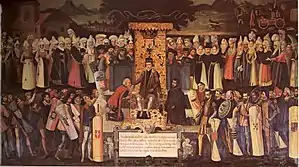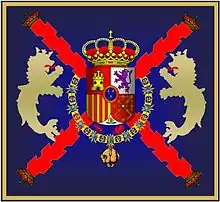Spanish Royal Guard
The Royal Guard (Spanish: Guardia Real) is an independent regiment of the Spanish Armed Forces that is dedicated to the protection of the King of Spain and members of the Spanish Royal Family. It currently has a strength of 1500 troops.[1] While the guard does participate in parades and other ceremonial events, it is a fully functional combat unit. Its members are recruited from the ranks of all three branches of the Spanish Armed Forces and receive the same combat training as regular soldiers.
| Royal Guard | |
|---|---|
| Guardia Real | |
 | |
| Active | 1504–1931 1949-present |
| Country | |
| Allegiance | King and Fatherland |
| Branch | |
| Type | Infantry, cavalry and horse artillery |
| Role | Executive protection Foot Guards Honor guard |
| Size | 1500 troops (1 regiment) |
| Garrison/HQ | Royal Palaces |
| Motto(s) | Al servicio de la Corona ("At the service of the Crown") |
| March | Himno de la Guardia Real ("Hymn of the Royal Guards") |
| Anniversaries | October 12 |
| Commanders | |
| Notable commanders | General Prim General Castaños |
The guard contains a diverse mix of units: a Royal Marines company from the Navy, a paratroop company from the Air Force and an infantry company from the Army, among others. Some units served in recent times in Afghanistan and Bosnia.
History

The history of the Royal Guard dates back to medieval times. The senior unit and one of the oldest body guards in the world is the Corps of Gentlemen of the Chamber, the Monteros de Espinosa, dating to 1006 and created by Sancho Garcia of the House of Castile.
Even before the time of the first monarch of Spain, the Catholic Monarchs formed the group called the Old Guards of Castile (Guardias Viejas de Castilla). Later on, the first monarch of Spain, Charles V ordered that a company of those guards to guard & reside in his palace, denominating it The Hundred Contines (Los Cien Continos)
Official formation
Later on, Charles V's father, Philip the Handsome arrived in Spain in 1502 brought with him his "Archers of Burgundy" aka "of the Blade". These group of Royal Guards with their Burgundian style, together with two units of halberdiers, will remain in service until the reorganization of the "Troops of the Royal Household" (Tropas de Casa Real) by Felipe V. During his reign, the royal guards were organized into:
- Headquarters
- Royal Guards Halberdiers
- Royal Carabinier Guards
- Musketeers of the Royal Guards
- Guards de Corps (organized as a squadron)
- Two guards infantry regiments (Wallon Guards and Guards of Spain)
In the 19th century the guards were reinforced by the Spanish Marine Infantry, which formed its own unit.
In 1824-25 the Guard was expanded into a full independent army group reporting to the sovereign and the Royal Military Household with two full corps following the example of France's Napoleonic Imperial Guard and Borbon Restorationist Royal Guards:
- Internal Royal Guards Corps
- Halberdiers
- Guards of the Royal Household
- Guards de Corps
- Infantry units
- External Royal Guards Corps
- 1st Guards Infantry Division
- 1st and 2nd Guards Infantry Brigades, organized into two to three regiments of infantry
- 1st Guards Cavalry Division
- 1st and 2nd Guards Cavalry Brigades
- Royal Horse Artillery Battery
- Train Company
- Royal Guard Company of Sappers and Miners
- 1st Guards Infantry Division
- 2nd Guards Infantry Division (Provincial)
- Royal Guard Grenadiers Brigade
- Royal Guards Rifle Brigade
In the 1840s only the internal units of the Royal Guards remained as the others were disbanded or transferred to the regular Army. In 1868 the Halberdiers stood down, only to be reformed under King Amadeo I as the Royal Guard Battalion of one infantry company and one cavalry troop and revived as a full battalion under his successor Alfonso XII.
Civil War
The guards were disbanded in 1931 as a result of the formation of the 2nd Republic & was replaced by the "Presidential Horse Guards Squadron" (Escuadrón de Escolta Presidencial), which was a cavalry formation. By 1936, it included the infantry "Presidential Guards Battalion” (batallón de Guardia Presidencial), which remained loyal to the Republic during the civil war.
Restoration
Under Francisco Franco, By Decree of February 4, 1949, the Military House of the Generalissimo was reorganized and on the basis of the republican formations the "Regiment of the Guards of His Excellency the Head of State” (Regimiento de la Guardia de Su Excelencia el Jefe del Estado), later on the "Guards Regiment of HE the Generalissimo" (Regimiento de la Guardia de S.E. el Generalísimo), was activated, which included a mounted squadron (the Guardia Mora) which was first raised from surplus personnel of the Regulares. After several reorganizations, the unit would last until Franco's death as a combined arms guard regiment.
Upon Franco’s death & the ascension of King Juan Carlos as the head of state and commander in chief of the armed forces, the guard regiment was integrated into the new army under the king & formed the basis of what is now the modern day Guardia Real - the "Royal Guards Regiment" (Regimento de la Guardia Real), which is responsible to the king thru the Ministry of Defense. [2] In the 1980s it grew into a three-battalion regiment. Today it is a four battalion unit that serves as the procotol and security service of the Spanish Royal Family.
Role

The primary function of the Royal guard is to provide military security for the Monarchy. In addition to protecting members of Spanish Royal Family, the present functions of the unit include the protection of foreign heads of state visiting Spain, and of royal palaces such as the Royal Palace of Madrid (Palacio Real), the Palace of El Pardo and the Palace of Zarzuela.
The regiment is an active combat unit and has been deployed to Bosnia and Afghanistan. The guard regularly takes part in military exercises organized in conjunction with all three of the main branches of Spains military.
It is involved in the guard mounting ceremony (Cambio de la Guardia) at the Royal Palace on the first Wednesday of every month from 12 midday to 2pm (save for July, August and September).[3] It is present at military parades in the national capital of Madrid on official holidays including Fiesta Nacional de España and Día de la Constitución. Annually, it has a troop review during the Pascua Militar ceremony on 6 January.
Organization



- Commander of the Royal Guard ( Colonel )
- General Staff
- Personnel Logistics (1st SEM)
- Institutional Affairs (2nd SEM)
- Security and Intelligence, Preparation and Employment (3rd SEM)
- Material and Infrastructure Logistics (4th SEM)
- Economic Affairs Section (SAE)
- Occupational Risk Prevention Service (SPRL)
- Legal Advisor (ASEJU)
- Office of the Sergeant Major of the Royal Guard (SBMY)
- Religious Service (SRELG)
- Secretary
- Group HQ
- HQ Company
- Security Company
- 1st Security platoon
- 2nd Security platoon
- 3rd Security platoon
- 4th Security platoon
- Communications Company
- Formation Company
- 1st platoon
- 2nd platoon
- 3rd platoon
- 4th platoon
- Escorts Group
- Group HQ
- Military Control Company
- Perimeter Control Section
- Interior Control Section
- Bomb Detection/Attack Dog Section
- Motorcycle Section
- Alabarderos (Halberdiers) Company
- 1st Immediate Security Section
- 2nd Immediate Security Section
- Alabarderos Section
- Royal Escort Squadron
- Mounted Band of Timpani and Bugles
- Mounted Marker Squad
- Cuirassiers Troop
- 1st Lancers Troop
- 2nd Lancers Troop
- Royal Horse Artillery Battery
- Equestrian Training Unit
- Honors Group
- Group HQ
- Army Company "Monteros de Espinosa"
- 1st Platoon
- 2nd Platoon
- 3rd Platoon
- Drill Team Platoon
- Navy and Marine Composite Company "Mar Océano"
- 1st Platoon
- 2nd Platoon
- 3rd Platoon
- 4th platoon
- Air Force Squadron "Plus Ultra"
- 1st Flight
- 2nd Flight
- 3rd Flight
- 4th Flight
- Mountaineering Group
- Diving Unit
- Sniper Unit
- Logistics Group
- Group HQ
- Administration Company
- Maintenance Company
- Transportation Company
- Logistics Directorates
- Medical Unit
- Musical Unit of the Armed Forces Royal Guard
- Musical Unit HQ and High Command
- Military Band of the Royal Guard of Spain
- Corps of Drums of the Royal Guard (Drums and bugles)
- Fife Section and Pipe band
- Brass band of the Royal Guard
- Royal Guard Big band
- Royal Guard Chamber Ensembles
References
- redacción, La. "San Juan El Precursor de Cristo Rey". www.arzobispadocastrense.com. Retrieved 2020-02-19.
- Reseña histórica
- Archived February 19, 2013, at the Wayback Machine
External links
| Wikimedia Commons has media related to Spanish Royal Guard. |
- Official website of the Royal Guard (in Spanish)